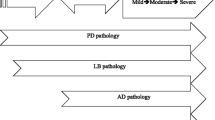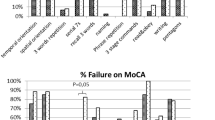Abstract
To examine the occurrence of fluctuating cognition (FC) in a group of patients with Parkinson’s disease with dementia (PDD), and to determine whether the presence of FC in PDD is associated with a pattern of cognitive and behavioural disturbances similar to the one shown by patients affected by dementia with Lewy bodies (DLB), a cluster analysis was carried out on the scores obtained by 27 PDD patients on the Clinician Assessment of Fluctuation Scale (CAF). The analysis separated the PDD patients into two subgroups, called PDD non-fluctuators (PDDNF; CAF ≤ 2) and PDD fluctuators (PDDF; CAF > 2). The two groups underwent a cognitive and behavioural evaluation. Their scores were compared with those obtained by DLB and Alzheimer’s disease (AD) patients. When exploring the cognitive performance of the patients with the Dementia Rating Scale-2 (DRS-2), PDDF had a similar pattern of impairments compared to DLB, which involved prevalently the attention and initiation/perseveration domains, and which was significantly more pronounced compared to that shown by PDDNF. The main behavioural finding of the study was the similar incidence of visual hallucinations in the PDDF and DLB groups, which was significantly higher compared to PDDNF and AD. Our results confirmed the hypothesis that subgroups with different cognitive profiles exist within PDD and that the occurrence of FC is the clinical variable associated with a DLB pattern of impairment in PDD. In conclusion, our study suggests that when FC occurs in PDD this syndrome becomes clinically undistinguishable from DLB.



Similar content being viewed by others
References
Aarsland D, Litvan I, Salmon D, Galasko D, Wentzel-Larsen T, Larsen JP (2003) Performance on the dementia rating scale in Parkinson’s disease and dementia with Lewy bodies: comparison with progressive supranuclear palsy and Alzhiemer’s disease. J Neurol Neurosurg Psychiatry 74:1215–1220
Aarsland D, Zaccai J, Brayne C (2005) A systematic review of prevalence studies of dementia in Parkinson’s disease. Mov Disord 20:1255–1263
Ballard CG, Aarsland D, McKeith I, O’Brien J, Gray A, Cormack F et al (2002) Fluctuations in attention: PD dementia vs DLB with parkinsonism. Neurology 59(11):1714–1720
Boeve BF, Silber MH, Ferman TJ, Smith GE (2002) Validation of a questionnaire for the diagnosis of REM sleep behaviour disorder. Neurology 58(Suppl. 3):A509
Bonanni L, Thomas A, Tiraboschi P, Perfetti B, Varanese S, Onofrj M (2008) EEG comparisons in early Alzheimer’s disease, dementia with Lewy bodies and Parkinson’s disease with dementia patients with a 2-year follow-up. Brain 131(pt3):690–705
Bradshaw J, Saling M, Hopwood M, Anderson V, Brodtmann A (2004) Fluctuating cognition in dementia with Lewy bodies and Alzheimer’s disease is qualitatively distinct. J Neurol Neurosurg Psychiatry 75:382–387
Chaudhuri KR, Healy DG, Schapira AH (2006) Non-motor symptoms of Parkinson’s disease: diagnosis and management. Lancet Neurol 5:235–245
Cummings JL (1997) The Neuropsychiatric Inventory: assessing psychopathology in dementia patients. Neurology May 48(Suppl 6):S10–S16
(1994) Diagnostic and statistical manual of mental disorders (4th ed. Revised) DSM-IV TR. American Psychiatric Association, Washington, DC
Fahn S, Elton RL (1987) Members of the Unified Parkinson’s Disease Rating Scale Development Committee. Unified Parkinson’s disease rating scale. In: Fahn S, Marsden CD, Calne DB, Goldstein M (eds) Recent development in Parkinson’s disease, vol 2. Mcmillan Healthcare Information, Florham Park, pp 153–164
Folstein MF, Folstein SE, McHugh PR (1975) “Mini-mental state”: a practical method for grading the cognitive state of patients for the clinician. J Psychiatr Res 12:189–198
Gearing M, Mirra SS, Hendreen JC, Sumi SM, Hansen LA, Heyman A (1195) The Consortium to Establish a Registry for Alzheimer’s Disease (CERAD), Part X: neuropathology confirmation of the clinical diagnosis of Alzheimer’s disease. Neurology 45(pt 1):461–466
Giladi N, Treves TA, Paleacu D, Shabtai H, Orlov Y, Kandinov B et al (2000) Risk factors for dementia, depression and psychosis in long standing Parkinson’s disease. J Neural Transm 107:59–71
Hoehn MM, Yahr MD (1967) Parkinsonism: onset, progression and mortality. Neurology 17:427–442
Hon N, Epstein RA, Owen AM, Duncan J (2006) Frontoparietal activity with minimal decision and control. J Neurosci 26:9805–9809
Horimoto Y, Matsumoto M, Nakazawa H, Yuasa H, Morishita M, akatsu H et al (2003) Cognitive conditions of pathologically confirmed dementia with Lewy bodies and Parkinson’s disease with dementia. J Neurol Sci 216:105–108
Hughes AJ, Daniel SE, Kilford L, Lees AJ (1992) Accuracy of clinical diagnosis of idiopathic Parkinson’s disease: a clinico-pathological study of 100 cases. J Neurol Neurosurg Psychiatry 55:181–184
Hulette C, Mirra S, Wilkinson W, Heman A, Fillenbaum G, Clark C (1995) The Consortium to Establish a Registry fro Alzheimer’s Disease (CERAD), Part IX: a prospective clinicopathologic study of Parkinson’s features in Alzheimer’s disease. Neurology 45:1991–1995
Inouye SK, Van Dyck CH, Alessi CA, Balkin S, Siegal AP, Horwitz RI (1990) Clarifying confusion: the confusion assessment method, a new method for detection of delirium. Ann Intern Med 113:941–948
Janvin CC, Larsen JP, Salmon DP, Galasko D, Hugdahl K, Aarsland D (2006) Cognitive profiles of individual patients with Parkinson’s disease and dementia: comparison with Dementia with Lewy bodies and Alzheimer’s disease. Mov Disord 21(3):337–342
Jurica PaulJ, Leitten ChristopherL, Mattis Steven (2001) Dementia Rating Scale-2 (DRS-2). Psychological Research Institute, Inc, Montreal
Lippa CF, Duda JE, Grossman M, Hurting HI, Aarsland D, Boeve BF et al (2007) DLB and PDD boundary issues. Diagnosis, treatment, molecular pathology and biomarkers. Neurology 68:812–819
McKeith IG, Dickson DW, Lowe J, Emre M, O’Brien JF, Feldman H et al (2005) Diagnosis and management of dementia with Lewy bodies: third report of the DLB Consortium. Neurology 65:1863–1872
McKhann G, Drachman D, Folstein M, Katzman R, Price D, Stadlan EM (1984) Clinical diagnosis of Alzheimer’s disease: report of the NINCDS-ADRDA work group under the auspices of department of health and human services task force on Alzheimer’s disease. Neurology 34:939–944
Pillon B, Boller F, Levy R, Dubois B (2001) Cognitive deficits and dementia in Parkinson’s disease. In: Boller F, Cappa S (eds) Handbook of neuropsychology, 2nd edn. Elsevier, Amsterdam, pp 311–371
Ravina B, Marder K, Fernandez HH, Friedman JH, McDonald W, Murphy D et al (2007) Diagnostic Criteria for Psychosis in Parkinson’s disease: Report of an NINDS, NIMH work group. Mov Disord 8:1061–1068
Shannon W (2008) Cluster analysis. In: Handobook of statistic, vol 27
Walker MP, Ayre GA, Cummings JL et al (2000) The clinician assessment of fluctuation and the one day fluctuation assessment scale: two methods to assess fluctuating confusion in dementia. Br J Psychiatry 177:252–256
Williams-Gray CH, Foltynie T, Brayne CEG, Robbins TW, Barker RA (2007) Evolution of cognitive dysfunction in an incident Parkinson’s disease cohort. Brain 130(pt 7):1787–1798
Williams-Gray CH, Foltynie T, Lewis SJG, Barker RA (2006) Cognitive deficits and psychosis in Parkinson’s disease, a review of pathophysiology and therapeutic options. CNS Drugs 20(6):477–505
Ziabreva I, Ballard CG, Aarsland D, Larsen JP, McKeith IG, Perry RH et al (2006) Lewy bodies disease: thalamic cholinergic activity related to dementia and parkinsonism. Neurobiol Aging 27:433–438
Acknowledgment
The first author would like to thank Prof. Alessandro Di Rocco for his kind revision and invaluable comments.
Author information
Authors and Affiliations
Corresponding author
Rights and permissions
About this article
Cite this article
Varanese, S., Perfetti, B., Monaco, D. et al. Fluctuating cognition and different cognitive and behavioural profiles in Parkinson’s disease with dementia: comparison of dementia with Lewy bodies and Alzheimer’s disease. J Neurol 257, 1004–1011 (2010). https://doi.org/10.1007/s00415-010-5453-3
Received:
Revised:
Accepted:
Published:
Issue Date:
DOI: https://doi.org/10.1007/s00415-010-5453-3




